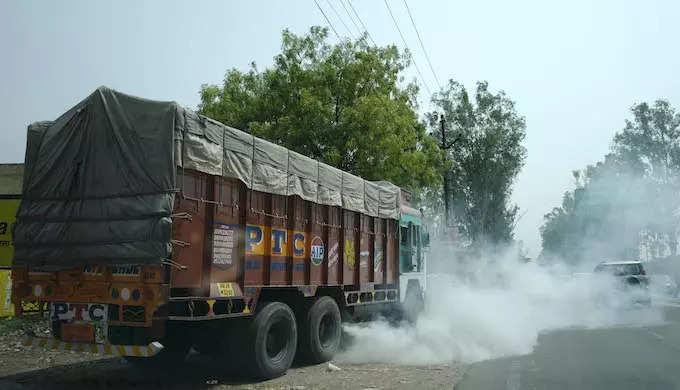
New Delhi: India moves on trucks. Unlike some developed economies where a fair share of freight is transported by rail and air, road transport continues to dominate freight movement in India. Nearly 4.6 billion tons of freight moves across the country annually, generating 2.2 trillion ton kilometres of transport demand.
But the peculiar Indian trait is this: nearly three-fourths of all goods are transported on trucks. And as the economy expands and the demand for freight movement increases, more and more trucks will be on the road.
A Niti Ayog study estimates the share of road transport in overall freight movement at 9.6 trillion ton kilometres by 2050, which means it will more than quadruple by then. The number of trucks in India will also grow by a multiple of four, from about four million now to about 17 million by 2050. Within road transport too, the share of heavy duty trucks trumps other vehicle categories, at 76%.
While an increase in overall freight movement is the mark of a healthy economy, this multiplication in the number of trucks moving across India would also mean a significant increase in emissions, since the trucking industry today primarily uses diesel. And heavy duty trucks are estimated to account for 45% of all on-road emissions. So what about our zero emission goals then?
One way to lower overall emissions is by transitioning to zero-emission trucks – which include trucks operating on battery or other alternative fuels. This can lead to 2.8–3.8 gigatons of cumulative CO2 savings between now and 2050. This saving would equal India’s entire economy-wide annual GHG emissions today, as per an analysis by the World Economic Forum.
So to encourage the rapidly expanding freight transport ecosystem to transition to zero emission movement, the WEF had, earlier this year, announced the setting up of a zero emission road freight cluster. This would be the first such cluster anywhere in the country. And this cluster is being supported by the Ministry of Ports, Shipping and Waterways as well as the NITI Aayog. The aim of this zero emission freight corridor is to bring together the government and the private sector to deploy over 550 zero-emission trucks in select road corridors along Gujarat and Maharashtra.
These two states have been chosen for the first zero emission cluster due to their large share in the country’s total road freight movement. Gujarat and Maharashtra account for a combined GDP of USD700 billion and ports in these states handle about 50% of India’s total volume of cargo.
Sudhendu Sinha, Adviser, Infrastructure Connectivity – Transport and Electric Mobility, NITI Aayog, had said earlier that Niti Ayog has already initiated the “e-FAST India” program to provide comprehensive support for the implementation of zero emission road freight solutions across India. Under this program, the government is working with the private sector to facilitate early deployment of sustainable technologies.
aCement is one of the commodities which moves along the zero emission freight corridor. The MD of UltraTech Cement, K C Jhanwar, had said at the WEF’s launch that the cement sector can provide an ideal use case for the early adoption of zero emission trucks. “At UltraTech Cement, we are committed to evaluating all means to reduce our emissions and environmental footprint. We see large scale deployment of zero-emission trucks and LNG/CNG vehicles as the next key initiative to make our operations more sustainable.”
But despite industry’s enthusiasm to participate in the zero emission freight corridor and bring down overall road transport emissions, it is a slow crawl to the finish line.
Anil Joshi, Managing Partner, Unicorn India Ventures, pointed out that while India has been able to manage conversion of intra-city commercial vehicles to CNG or electric vehicles, even this change is limited to the metros and big cities. “From the manufacturers’ perspective, the industry is ready and capable to produce (alternative fuel vehicles and EVs) But the infrastructure to support vehicles on CNG or electric is not available across the length and breadth of the country. To meet the zero emission deadline the government needs to work on building both CNG stations and charging points for vehicles to get charged or fill CNG to run the vehicle. Without proper infrastructure even if we have vehicles they can’t be run without refill stations or charging points hence there is need to build infrastructure enabling consumers to opt for clean fuel vehicles.”
Vishwachetan Nadamani, Chief Operating Officer, Ecom Express Ltd,, pointed out that in India, the transportation sector accounted for 14% of GHG emissions and freight transport accounts for over 40% of final energy used in the transportation sector. “This is considerably high compared to global shipping and transportation sector numbers, at only 3% of GHG emissions. Hence, sustainability as a theme is critical for the Indian logistics sector,” he said.
Nadamani said that among the top electric vehicle models available in India currently, less than one ton of weight can be carried and these vehicles have a range of 100 km – the distance they can be operated with single charge. “For long haul, a range of 200 km and capacity of three tonnes is the bare minimum required,” he said. Ecom Express has deployed about 150 CNG/ EV trucks in the first mile and line hauls.
Sachin Haritash, Director at Chetak Logistics, said that the government has begun installing infrastructure at zero emission freight corridor and the first part would be installing solar panels along the highways to enable ‘green’ electricity supply to the charging stations coming along this corridor.
“The government and the industry are moving in the right direction to reduce emissions. But it will take a few years for the zero emission corridor to become a commercial reality,” he said.
Chetak itself is looking to become carbon neutral by 2030 and has begun replacing diesel vehicles with CNG (for mid-haul vehicles which transport cargo up to 800 km and can carry up to nine tons of weight). Last mile, small vehicles are being converted to EVs.

















